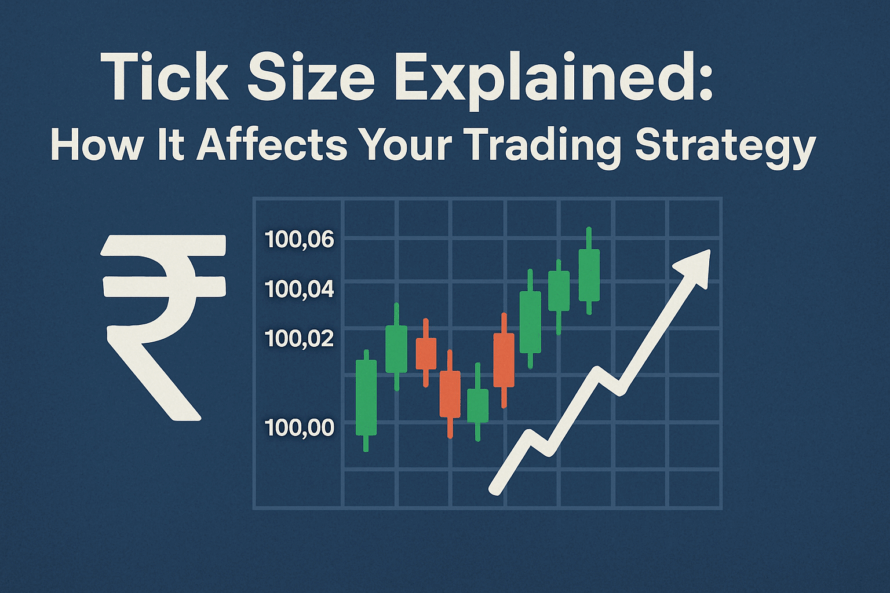
Share prices are subject to frequent fluctuations in financial markets. Electronic trading allows traders to spot every small price rise or fall instantly. The smallest change in the price of trading instruments is referred to as the tick size. Learning about tick size is important. It supports better trading strategies and better results during trading. A tick in trading refers to the smallest amount an asset’s price can change.
The idea is simple, but it plays a key role in developing trading plans for the stock market. Knowledge about ticks lets you make better decisions when you trade, encourages confidence during trading, and helps you succeed more frequently in the market. Read this guide to learn more about tick trading and tick sizes in the financial markets.
Understanding tick size in financial markets
Ticks are the smallest changes you can observe in the financial markets. For instance, if the price of a stock increases from ₹100 to ₹100.05, it has a tick size of ₹0.05. Ticks guide you in deciding how to buy and sell by making you aware of the tiniest possible change in price. It gives you the power to know when to make a move in the market.
Tick size can vary from one market to another and from one traded security to another. Some stocks only move up or down in increments of ₹0.01, but others move in ₹0.05 steps. You should learn about ticks and tick sizes to better understand how to make good trading choices.
• Definition and Origin of Tick Size
In the beginning, tick sizes in financial markets were given as fractions. In the US stock market, the smallest change in price was $0.0625 because prices were set in fractions of $1/16. In 2001, the US SEC changed that stocks must now be priced using decimals rather than fractions. The goal was to make it simpler to understand prices and make trades more accurate by decreasing the smallest unit prices that could move in trading to just one cent ($0.01). The change led to better bid-ask spreads, resulting in less expensive trading and greater liquidity.
• How Tick Size is Measured Across Various Markets
Tick sizes in today’s trading are most often expressed as decimals. For most of the early 2000s, the US stock markets showed prices rounded to the nearest penny per unit. Most stocks used a tick size of $0.0625, one-sixteenth, but some less active or liquid issues had 1/8 ticks, and more active ones had 1/32 ticks.
In 2005, the SEC made Rule 612, the Sub-Penny Rule, part of its regulations. Rule 612 said stocks trading above $1.00 had a minimum tick size of $0.01, and those below $1.00 had a minimum tick size of $0.0001.
Implications of tick size on trading strategies
There are usually many market participants involved in the financial markets. Most traders interested in various exchanges use scalping, day trading, and swing trading strategies. We should remember that tick size plays a significant role in shaping most trading strategies. Scalping is when someone tries to profit from quick changes in price during a brief time span. The ability to scalp and how much profit can be made largely depend on the tick size.
Day trading means making several trades during the same day to profit from price changes as they happen. The cost of entering or leaving a position depends heavily on tick size. Swing trading involves holding assets for a few days to take advantage of bigger shifts in the market. The size of the tick influences an investor’s entry and exit points.
• Role of tick size in price movement and volatility
You should focus on managing tick size to optimize your trading strategies and boost your returns. During volatile times, it helps to use small tick sizes to keep an eye on every price detail. In steadier markets, bigger tick sizes allow you to follow significant trends, as little temporary changes won’t distract you.
Less variation in tick sizes means it is easier to pinpoint your desired price, and you will pay less per trade. Still, keeping traders busy with more trades could lead them to pay extra for commissions.
• Tick size’s impact on market liquidity and order execution
The depth and arrangement of orders on the order book are shaped primarily by tick size. When the tick size is well balanced, the market concentration remains at essential levels. When tick sizes are really fine, liquidity can be divided among numerous prices, making the market more volatile and less likely to offer good order prices.
Tick size variations in different financial instruments
Tick sizes vary from one financial market to another, as the size of a tick depends on the rules, trading structures, and characteristics of the investments.
• Tick Size in Stock Markets
Tick size in the stock market means the smallest change in price a stock can make. The regulatory bodies like SEBI in India and the SEC in the USA establish the increments to safeguard the order and stability of the market. In India, for stocks having a market capitalization above ₹10,000 crores, the tick size is usually ₹0.01. When stocks fall in the range of ₹3,000 crores to ₹10,000 crores market cap, they are traded in increments of ₹0.05 each.
• Tick Size in Forex Trading
The tick size in forex trading is the smallest change you can see in the price of a currency pair. It indicates the high level of accuracy given to prices when exchanging currencies. The size of ticks in forex can determine the costs and targets of every trade. For traders, tick size helps them determine the benefits and risks associated with each position.
• Tick Size in Futures and Options Trading
In futures trading, how much the price can change is measured by tick size, and this can influence a trader’s results. Futures contracts are set up with a preset tick size that depends on their criteria. In India, Nifty 50 futures contracts use a tick size of ₹0.05. Tick size is the smallest amount by which an option contract value can change. During moments of high volatility, the accuracy of pricing is greatly improved by having small tick sizes. When prices are above ₹3 in India, the minimum change the market allows is listed as ₹0.10.
Regulatory aspects of tick size
Tick size regulations define the least change in price you can find in an exchange for any financial instrument. Such regulations are made through the functions of organizations such as SEBI in India and the SEC in the US. Bigger or smaller tick sizes can affect how prices are discovered, the amount of liquidity, and trading plans.
• How Regulatory Bodies Determine Tick Size
The price movement allowed for any stock in the Indian stock market is called the tick size. It is often shown in rupees and depends on each company’s stocks, considering their price, volatility, and required regulations. If the tick size of a stock is 0.10 rupees, that means a stock’s price in this market can go up or down by only 0.10 rupees. This is set by the country’s exchanges and regulators, such as the Securities and Exchange Board of India (SEBI).
• Recent Changes in Tick Size Regulations in India
The National Stock Exchange (NSE) has declared that the size of ticks for stocks and futures will change, effective April 15, 2025. Tick size shows the smallest change in price that can occur between the buyer and seller in an order. Here’s the new structure:
Below ₹250, the tick size is equal to ₹0.01 (1 paisa).
₹250–₹1,000 → Tick size = ₹0.05 (no change)
Between ₹1,000 and ₹2,500, the tick size is ₹0.10.
From ₹2,500 to ₹10,000, the tick size is equal to ₹0.50.
Tick size = ₹1.00 → ₹10,000 to ₹20,000
Strategic trading decisions based on tick size
Tick size is important because it decides how the price moves, and it influences your trading expenses. Due to tighter exit and entry points, tick sizes can help cut down on the difference between the buy and sell prices. Yet, the use of these tools can lead to more frequent trading, which can increase the amount you have to pay in fees. Considering tick size when you formulate your strategy will support good trading decisions and help control the expenses involved.
• Setting Profit Targets and Stop-Loss Orders
Setting both profit targets and stop-loss orders depends a lot on the tick size. Traders check that these levels are in line with the tick size so that possible gains and losses balance with the small increases and decreases found in the market.
• Adapting Trading Strategies for Different Tick Sizes
Having a small tick size allows investors to act fast and with accuracy. Each position change is set at a specific price, so traders can manage their trades when they want. Calculating returns and risks for a trade involves looking at the tick size. If one tick means a change of ₹0.05 in a market, traders are clear about what each movement means for their profits or losses. A well-defined purpose makes it possible to design better strategies and get a fair return while managing risks.
Conclusion
Understanding tick size is necessary to succeed in the financial markets. Knowing the tiniest price movement gives you more control and better trading approaches, no matter which assets you buy and sell. Advances such as decimalization underline the value of regulations in making the markets more effective.
You can improve your trading results by following market trends, making use of advanced tools, and being up-to-date with all required regulations. Understanding tick size gives you the confidence and accuracy to handle the market’s challenges.
FAQs
Q. What are the key benefits of understanding tick size in trading?
Tick size is essential in the market due to its effects on trading and investors’ decisions. It gives investors exact prices for making their trades on the exchange, making it very important to be precise when executing trades. Tick size also influences liquidity. Consistent tick sizes make the market fair and clear by giving everyone the same information and chances to make trades.







